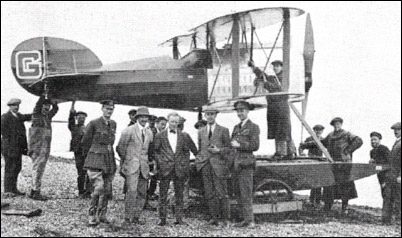| Graham Summers, e-mail, 20.12.2015 23:57 As the previous winner of the Schneider Trophy (back in 1914), the task fell to Britain to organize the first competition after the First World War in 1919. Amongst the British entries for the competition was the Avro Type 539, named the Schneider. The Type 539 was a single-bay, unstaggered biplane, which was made as small as possible to get the maximum amount of power from the 240hp Armstrong-Siddeley Puma engine. The aircraft was fitted with ailerons on both wings to maximize the maneuverability of the Type 539, especially at the low altitudes flown by Schneider participants. The Type 539 made its maiden flight on 12 August 1919, just 12 days before the Schneider Trophy was due to begin. During the first test flight, its flight characteristics were described as quite satisfactory. However on the second flight, one of the twin floats was damaged by floating debris, which necessitated a trip back to the Avro Factory at Hamble. Not only was the float repaired, but also the opportunity was taken to both balance the rudder and elongate the fin. With five days to go to the commencement of the races, the now-designated Type 539A took to the skies once again. The Schneider Trophy began on 10 September 1919, but soon after the commencement of the series of races, the Type 539 was eliminated due to poor performance. As a result the aircraft was used as a training machine for the rest of the competition by the British team. Registered G-EALG, just prior to the race series commencement, the Type 539 was flown back to Hamble, where it was eventually converted to landplane status, with a new smaller fin. Still registered as G-EALG, the Type 539A was entered in the Aerial Derby on 24 July 1920, and was flown by test pilot Denis George Westgarth-Heslam. The Type 539A was doing well when having passed West Thurrock a fuel line fractured, saturating the pilot in petrol. Westgarth-Heslam was forced t make an emergency landing at Abridge, also in Essex. The Type 539A was returned to the Avro Factory at Hamble, and underwent another transformation, which saw the Puma engine, replaced by a 450hp Napier Lion powerplant. Avro also fitted one of their own propellors to the Type 539B as it had become. The change in designation also saw a change in registration with the Type 539B becoming G-EAXM, with the aircraft poised to attempt to take part in the 1921 Aerial Derby. Pilot for the competition was again Westgarth-Heslam, who had received a broken leg, towards the end of the previous year, following a crash. Some sources indicate that Westgarth-Heslam should have stayed off flying for at least another three months, but he persuaded the Avro Management that he was fit for the task. On the day before the Aerial Derby, 15 July 1921, Westgarth-Heslam, took the Type 539B for his first flight in the type. However he was surprised by the increased landing speed, no doubt as a result of the more powerful engine. It led him to land too far down the runway at Hendon, leading to the aircraft overshooting the end of the runway, going across a railway cutting and into the area, which previously had been the Aircraft Assembly Park. The aircraft was wrecked and a write off, and Westgarth-Heslam ended up breaking his leg once again! reply |











